7-Card Stud Hi-Lo, generally known as “Stud 8” because of the requirement for an 8 low or better to win the low half of the pot, could be the player’s best poker game.
Though it is not generally spread as a cash game in a public poker room, when it is spread, it often attracts many poor players who don’t understand some fundamental winning concepts of the game.
In this guide, pro poker player Ashley Adams will teach you both the basics of playing Stud 8, and a winning strategy for the game.
When you are done, you should be able to play Stud 8 with enough competence to at least break even, if not win a small amount.
And you will have the tools that, with some experience and further thought, you should eventually be able to win regularly.
Here’s what you’ll learn:
Let’s dive right in!
Author’s note
Stud 8 is a regular feature in mixed-games tournaments. It is the E in The Hi-Lo mixed game of OE (Omaha 8 and Stud 8), and the E in HORSE, HOSE, and SHOE.
Stud 8 is a variation of the classic game of 7-Card Stud, that combines both that game with Razz Poker (the variant that awards a pot to the lowest hand).
Quick History of the Game
7-card Stud Hi Lo has been spread in casinos since the 1970s. In the late 1970s and early 1980s, a qualifier was added that required the winner of the low end of the hand to have no worse than an 8 low.
As the game is currently played in public poker rooms today, there is always an 8 qualifier, and the game is often referred to as Stud 8.
How the Game is Spread Today
Stud 8 is always played “cards speak”, meaning that players do not announce or determine in any way whether or not they are competing for the high or low side of the pot (or both).
In Stud 8, all players compete for both sides of the pot without a declare; their cards alone determine whether they win or tie in both directions.
The game is to be distinguished from other versions of the game that involve a declare.
While 7-Card Stud Hi-Lo declare is also a great game, it is only spread in home games – never in a casino or other public poker room.
You should learn Stud 8, as you should learn all poker variants, in order to take advantage of whatever game is being spread, either in a cash game or in a tournament. That may go without saying.
Fun Fact
What you may not know is that Stud 8 provides the good player with probably the best opportunity to win money in a typical game. The reason for this potential profit is that Stud 8 probably has the largest percentage of players who are playing the game the wrong way.
By knowing the basic strategy presented here, you will have a significant skill advantage over the typical Stud 8 player.
The skill advantage determines your eventual profit in any game.
That’s not to say you will win every single time you play. But by learning a good basic strategy of the game, even before you are an expert, you are more likely to have an advantage against the typical line-up of opponents than in any other poker variant.
Stud 8 follows the rules of 7-Card Stud with a few important exceptions, including how the pot is awarded. The exceptions are listed and explained below.
Stud 8 has the same rules as 7-Card Stud except:
- There is no option to bet the big bet on fourth street when a player shows a pair. They only have the option of betting the small bet.
- The pot is awarded not to the high hand alone, but is instead divided between both the highest standard poker hand and the lowest poker hand, provided the lowest poker hand is at least an 8 low.
- A showdown without a player with at least an 8 low is awarded entirely to the high hand.
- Tie hands in either or both directions divide their share of the high and/or low half of the pot.
- If there is an odd amount in the pot when splitting the pot between high and low, that amount goes to the high hand.
Like 7-Card Stud and Razz, Stud 8 is played with both an ante and a forced bet.
The forced bet in Stud 8, as in Stud, has historically come from the lowest exposed card on third street (though, this is beginning to change in tournaments, where some have started to have the high card bring-in the bet, as in Razz).
Typically, the ante is a small percentage of the small bet, typically between 10% and 20%. In a $10/20 game, for example, the ante is $1.
In the $75/150 game the ante is $15.
The forced bet is also a fraction of the small bet – typically 30% or so.
In a $10/20 game the forced bet is typically $3. In the $75/150 game it is typically $25.
The bets in Stud 8 are limited on each street.
Third and fourth street are the small limit; fifth, sixth, and seventh street (“the river”) are the big limit. In Stud 8, as in all forms of stud, the forced bet on third street may be completed to the full small bet, initially by the player with the forced bet, or completed subsequently by another player.
Once it is completed, it may be raised by the small limit by any player.
Typically, in Stud 8, there are three or four raises allowed in each round of the hand, though if the round begins heads up there is typically no limit to the number of raises allowed, except in a tournament when, typically, the raise limits still apply.
Here's how a typical hand might go, street by street. I’ll expose all cards in this example of the betting structure. This is a $75/150 game with a $15 ante and a $25 forced bet.
- Bob: (Ts Js) Qc;
- Biff: (9d Qh) Qs;
- Bo: (Td 6c) Jd;
- Jaio: (2d 5d) 3s;
- Joe: (Kh Kc) 2h;
- Jill: (4s 2c) Tc;
- Kye: (Ks 7s) 4h;
- Zak: (7c Kd) 8h.
Third Street
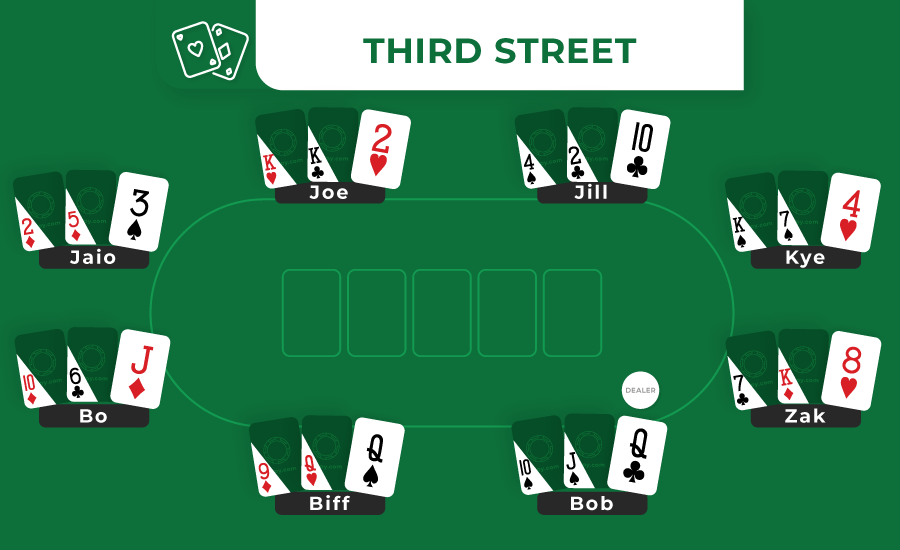
The players ante $15 each. $120 in antes in the initial pot.
Joe is the forced bet, and bets $25.
The bet then passes to Jill who calls the $25. Kye folds, Zak folds, Bob calls $25, Biff completes the bet to $75 with a pair of Queens. Bo folds. Jaio calls the $75. Joe raises to $150 with his pair of Kings, Jill folds, Bob calls the raise for another $50. Biff re-raises to $225.
Jaio calls the additional $75. And Joe caps the betting by making the third raise to $300. Bob calls the raise as do Biff and Jaio.
Eight players anted $15 each for a total of $120.
One player folded after calling the $25 bet. Three players folded without calling any bet. And four players are in for the full completed bet and three raises of $300, totaling $1200. $1345 is in the pot leading to fourth street.
Four players, Bob, Biff, Jaio, and Joe, receive a second up card and see Fourth Street.
Fourth Street
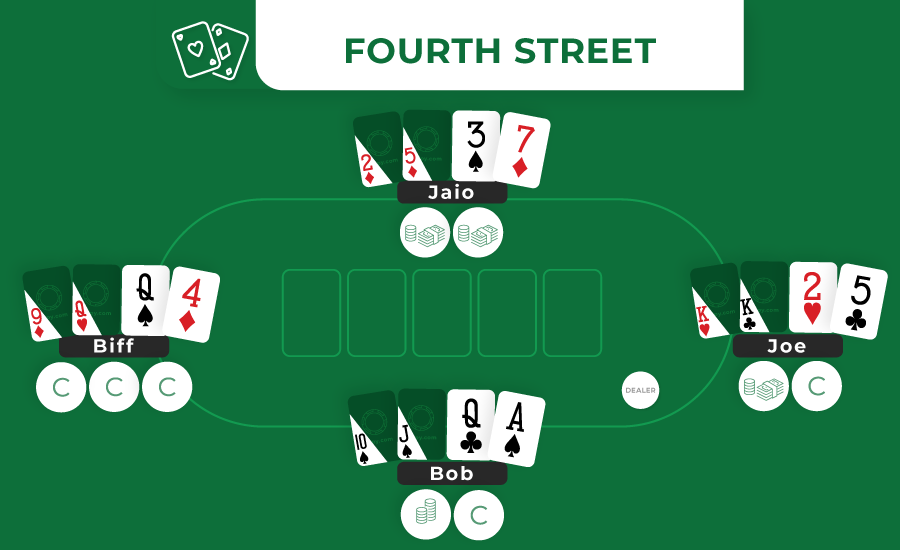
- Bob: (Ts Js) Qc As
- Biff: (9d Qh) Qs 4d
- Bo: (Td 6c) Jd
- Jaio: (2d 5d) 3s 7d
- Joe: (Kh Kc) 2h 5c
- Jill: (4s 2c) Tc
- Kye: (Ks 7s) 4h
- Zak: (7c Kd) 8h
Bob is high and begins the betting, with the option to either check or bet. He bets $75. Biff calls. Jaio raises to $150. Joe re-raises to $225. Bob calls. Biff calls. Jaio re-raises, capping the betting at $300. Joe calls. Biff calls. $1200 more in the pot.
Total of $2545 in the pot. Four players all see Fifth Street.
Fifth Street

- Bob: (Ts Js) Qc As 9c
- Biff: (9d Qh) Qs 4d 2s
- Jaio: (2d 5d) 3s 7d 7h
- Joe: (Kh Kc) 2h 5c 6s
The big bet of $150 starts on this round.
Jaio has the highest board with her pair of 7s. She checks. Joe bets $150. Bob calls. Biff calls. Jaio calls.
$600 is added to the pot of $2545. $3145 in the pot going to sixth street with four players.
Sixth Street

- Bob: (Ts Js) Qc As 9c 3h;
- Biff: (9d Qh) Qs 4d 2s 5s;
- Jaio: (2d 5d) 3s 7d 7h 8c;
- Joe: (Kh Kc) 2h 5c 6s Ac.
Jaio still has the highest board with a pair of 7s. She checks. Joe bets $150. Bob calls. Biff calls. Jaio calls. $600 is added to the $3145 in the pot.
The pot stands at $3745 going to the river with four players.
Seventh Street (The River)
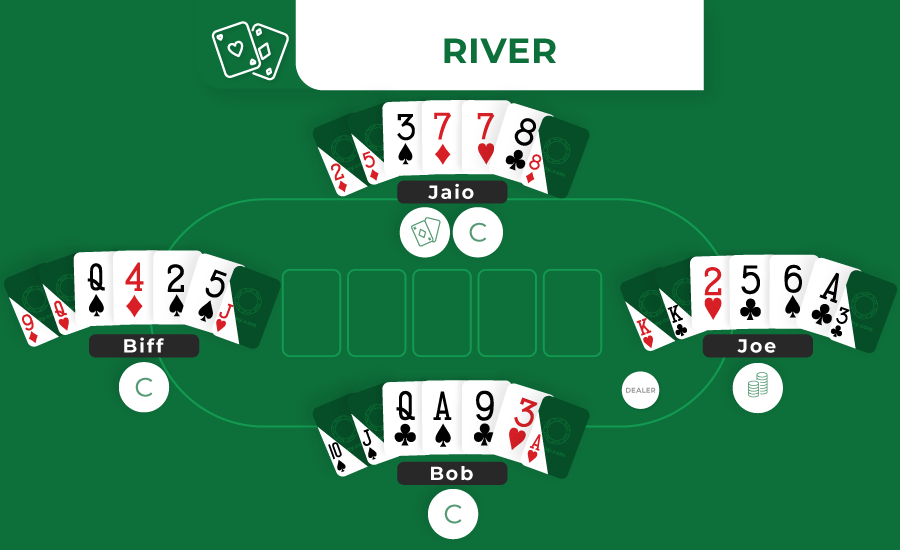
- Bob: (Ts Js) Qc As 9c 3h (Ah);
- Biff: (9d Qh) Qs 4d 2s 5s (Jh);
- Jaio: (2d 5d) 3s 7d 7h 8c (8d);
- Joe: (Kh Kc) 2h 5c 6s Ac (3c).
Jaio is once again the high exposed hand and has the first betting option. She checks. Joe, with a very strong low hand, bets $150. Bob, with a pair of Aces, calls. Biff calls with his pair of Queens. Jaio, with a rough 8 low and two little pair calls.
$600 gets added to the pot of $3745 for a total pot of $4345.
They all reveal their hands.
- Bob has a pair of Aces for high. Bob has no qualifying low, with no better than a JT for low.
- Biff has a pair of Queens for high. Bob has no qualifying low, with no better than a J9 for low.
- Jaio has two pair, 88775 for high. Jaio has an 87532 for low.
- Joe has a pair of Kings for high. Joe has 6532A for low.
Jaio has the best high hand with her two pair.
Joe has the best low hand with his 65 low.
The pot is split.
Jaio receives $2,173 for her high half of the pot. Joe receives $2,172 for his low half of the pot.
(When pots are split, and it’s not possible to split them evenly, the high end of the pot gets the extra remainder in the split.)
For a complete ranking of the high hands, check out the image below:
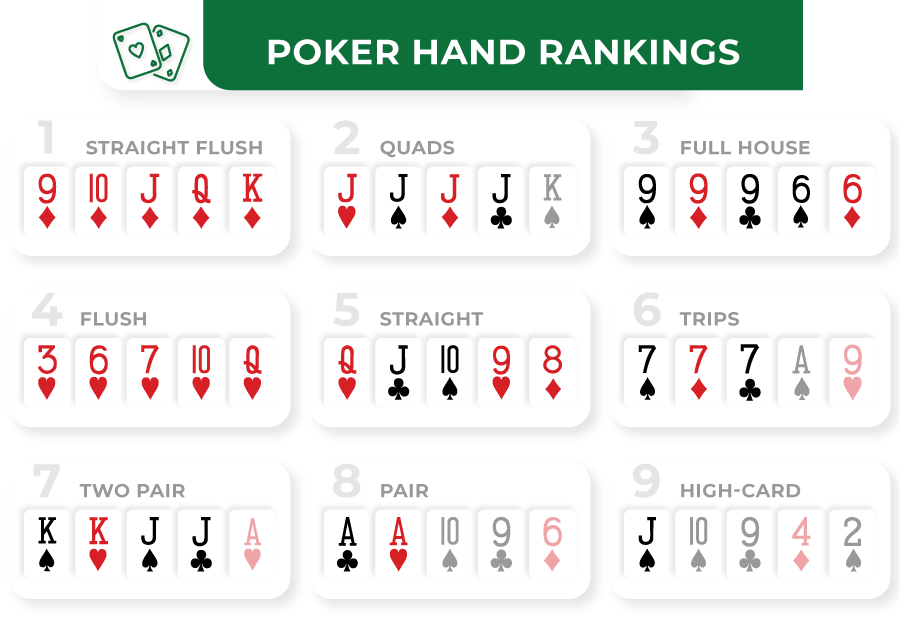
For a listing of the most valuable low hands please see the image below:
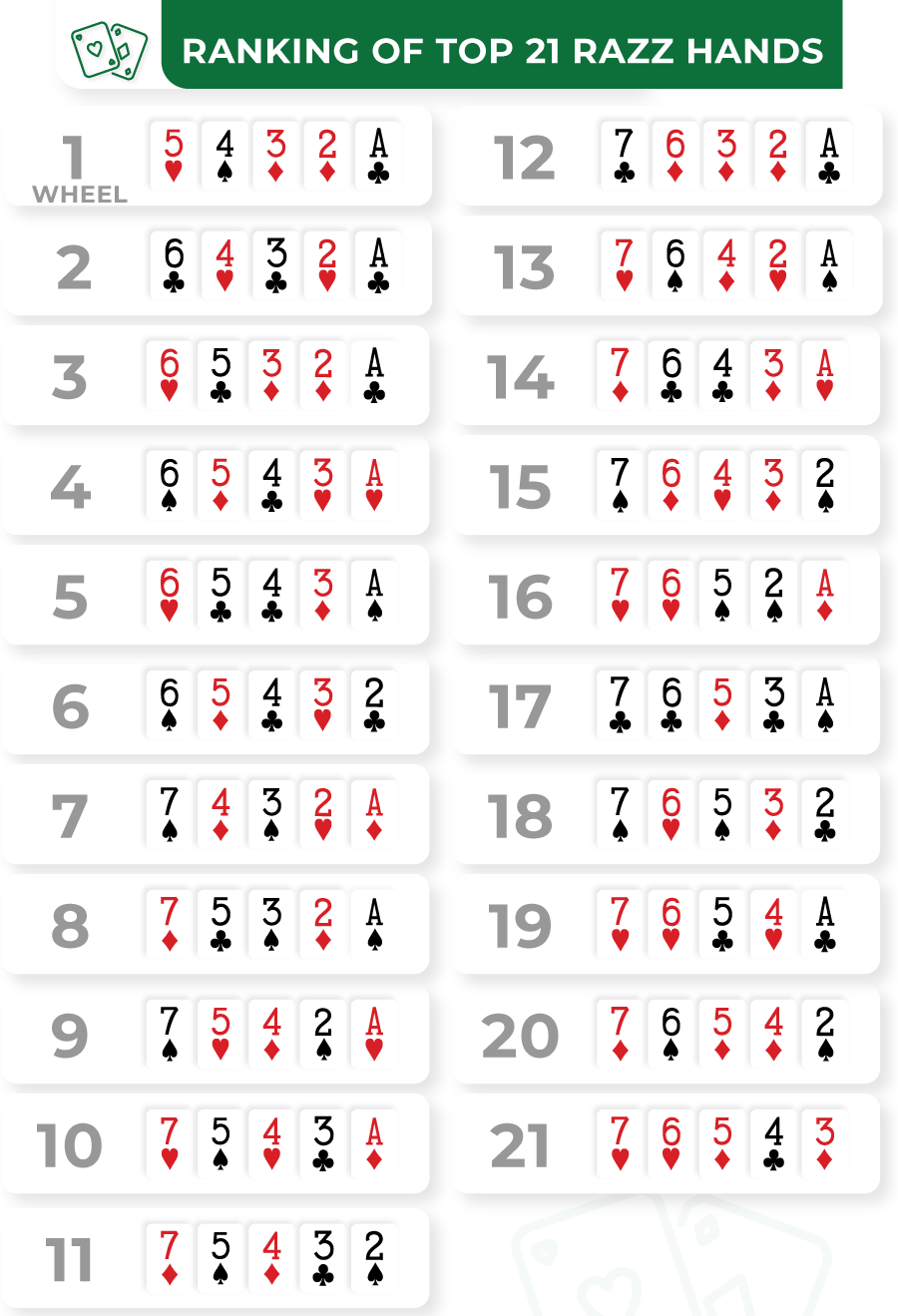
The key to basic Stud 8 poker strategy is to recognize that the object of the game is not to win half the pot, but to scoop the pot.
Many players, including some otherwise good players (as well as some poker authors) totally misunderstand this. They see the game as a combination of Stud and Razz, where you have twice the opportunities of winning.
They play those hands that have a good chance of winning either high or low, and sometimes both.
This is a huge error. And it’s the chief reason that Stud 8 is so profitable for those who understand how to play it correctly.
You will learn to play only those hands that have at least a fairly good chance of winning the entire pot. That’s not to say that you will always do so. But being mindful of that goal, you will limit your starting hands accordingly.
As it turns out, this means that, on average, you are playing fewer hands in Stud 8 than in either Razz or Stud. You are playing fewer hands, and you are not necessarily playing them in the same way as you would play them in either Stud or Razz.
Remember
Rather than playing Stud 8 as you would play either Razz or Stud, you will instead pay close attention to how you will win your money in this unique game; not how you will win half the pot.
Unlike Stud and Razz, you will not always be the aggressor when you think you are in the lead in either direction.
And you will not always play passively when you are on a draw.
Instead, you will look to how best you can win money from your opponents, which may involve being aggressive when you are behind or being passive when you are ahead. And that involves some subtleties unique to this form of the game.
In general, you want hands that play well for low, but also have some way of becoming high hands. You generally want to avoid playing premium pairs, unless they are Aces, as they have little chance of becoming winning low hands.
You have to pay close attention to and keep track of the low cards that you need and the low cards that pair you.
Here’s a list of the potential two-way hands that you should consider playing:
Three Suited Babes with the Ace
These are the super-premium hands. They have many ways of scooping. They could scoop by making an excellent low and a straight or a flush. And they might deceptively cause your opponents to fold incorrectly, appearing to be one hand as they develop, but really being another hand. This too could help you scoop.
Consider the illustrated hand:
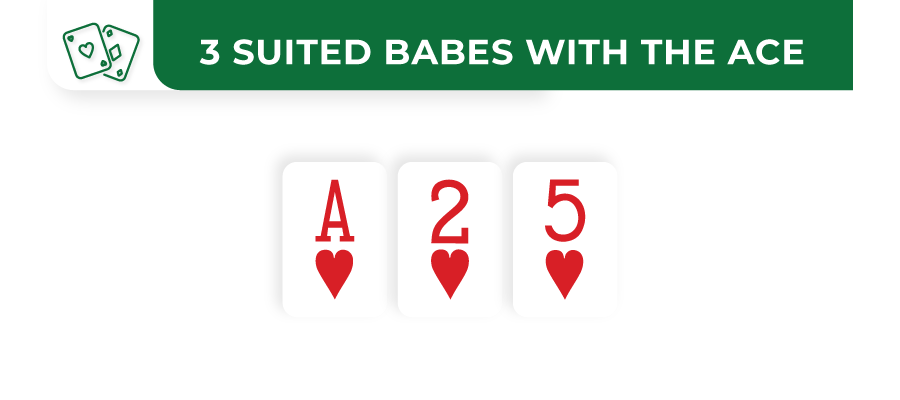
On fifth street it might become: (Ah 2h)5h 8s As
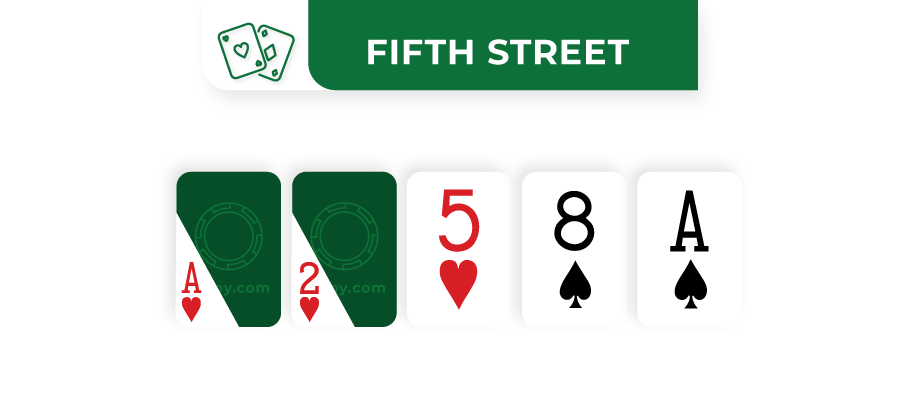
It looks like you might have just made a low. It’s really a pair of Aces and a four-card low draw – a very strong hand both ways.
A player drawing to a low might fold if you bet or raise, figuring you are drawing to a wheel with a made 8.
A player with a pair of Kings might make the same incorrect conclusion and keep playing his losing hand. You might end up heads up against a pair of Kings with no low draw.
That would be ideal – greatly increasing your ability to scoop against him.
Three Low Cards to a Straight
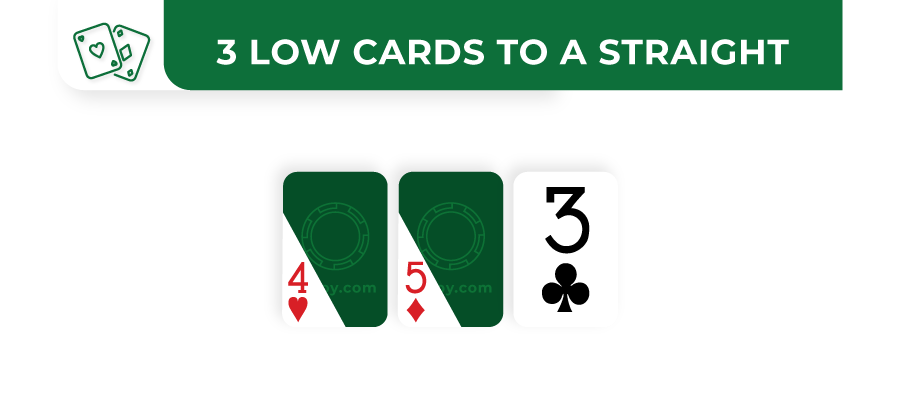
(4h 5d) 3c. It’s got a great start toward a low; and it could back into a little straight that could win the high half of the pot as well.
A Pair of Aces with a Low Card, Especially a Suited Low Card
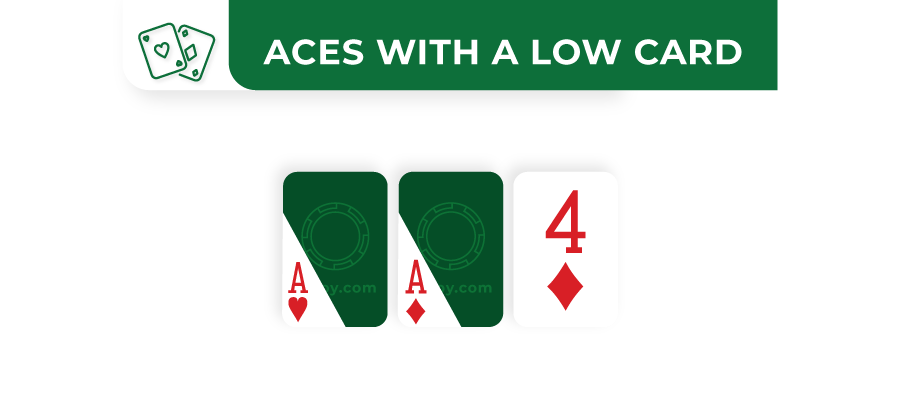
(Ah Ad) 4d. This is another premium hand, as it is probably the best high hand, and it has a shot of making a low as well.
Tempting but Not Good Starting Cards
Not all good starting hands for Stud are good in Stud 8. Here are some hands that look better than they are:
Premium Pairs
Consider this hand: (Qs Js) Qh
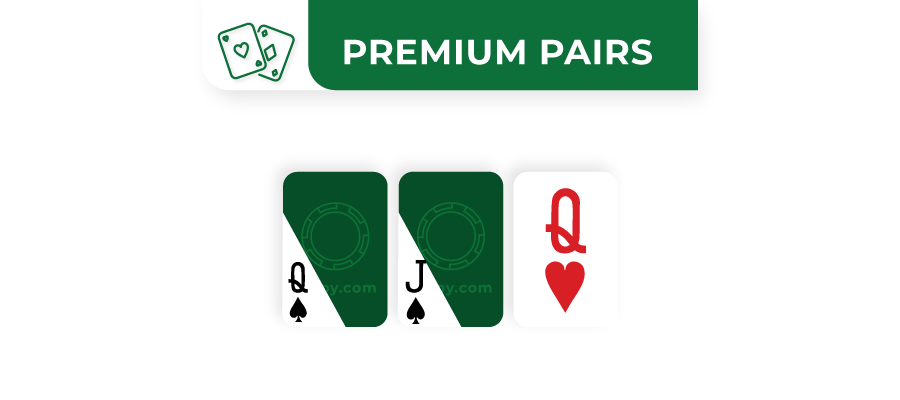
It’s a strong start for Stud, with a pair and suited connectors (especially if the spades and connecting cards are live).
But in Stud 8 this is a trash hand and should be folded to a complete bet, and maybe even for the bring-in.
Unless you catch another Queen you are likely to be second best or worse. And you have absolutely no chance of winning low.
In general, premium pairs are not good hands in Stud 8, unless they are Aces.
High Flush and Straight Draws
Consider these hands: Kh 7h Th or Qs Jh Th

The 3-flush and 3-straight are each playable hands in Stud that are not good in Stud 8. High flush and straight draws don’t make lows and should generally be discarded.
List of Playable Hands
Here's a list of the hands you should play for a complete bet. The one exception to playing only two-way hands is trips.
It is generally good enough to play for a raise on third street, through to the river, with the possibility that there will be no qualifying low and that you win unimproved or fill up.

- A set of babes: [2c 2s 2d]
- A set of low cards: [7h 7d 7c]
- A set of high cards: [Ts Tc Td]
- Three suited babes headed by the Ace: [Ah 3h 5h]
- Three suited babes: [ 2h 4h 5h]
- Three suited low cards in sequence: [5d 6d 7d]
- Three suited low cards headed by the Ace: [Ac 7c 5c]
- Three suited low cards: [7d 5d 2d]
- Pair of Aces and a suited babe: [As Ac 3c]
- Pair of Aces and an unsuited babe: [As Ac 3d]
- Pair of Aces and a suited low card: [Ac Ad 7c]
- Pair of Aces and an unsuited low card: [Ac Ad 7s]
Conditionally Playable Hands
Split pair of Aces with non-low card [Ac Js] Ad
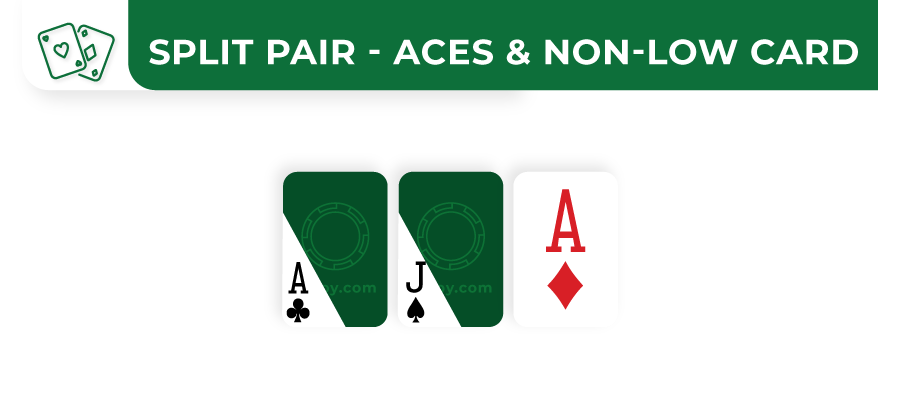
These hands can be good because players may misread your hand if it develops in a low direction – and fold their low draws against you, allowing you to scoop a pot for high.
They are not good if an opponent looks like they may have a better high hand, or if it’s clear that opponents will stick around and freeroll you with made lows.
Concealed pair of Aces and another non-low door card [Ac Ad] Js
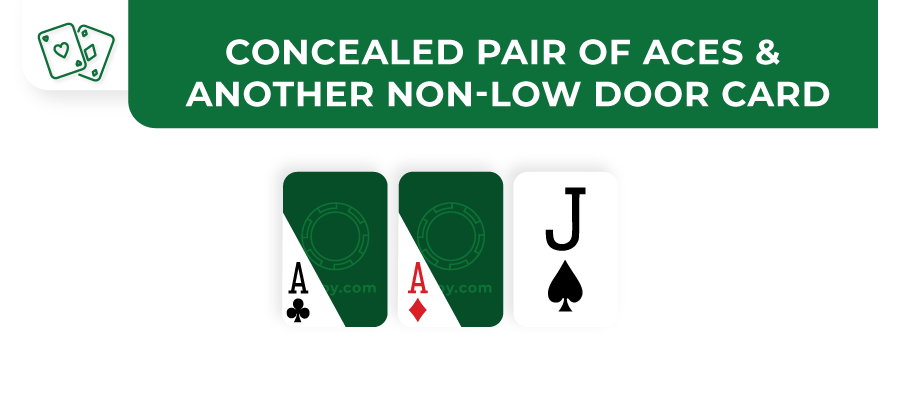
This is good for deceptive purposes if it is able to convince an opponent with QQ or KK to play against you, assuming incorrectly that you have a pair of Jacks.
It works with at least a couple of low hands playing against you – who don’t appear to have much in the way of better high card draws.
You have to be careful because any two pair, trips, straight, flush or better will beat your unimproved pair.
Low pair and suited consecutive low card [6s 5s] 5d

You really need a perfect card on fourth street for this hand to be playable on later streets.
You need either a low card, preferable connected or suited, or another 5. Only play this if the cards you need are very live.
Concealed premium pair and babe door card [Ks Kd] 2c
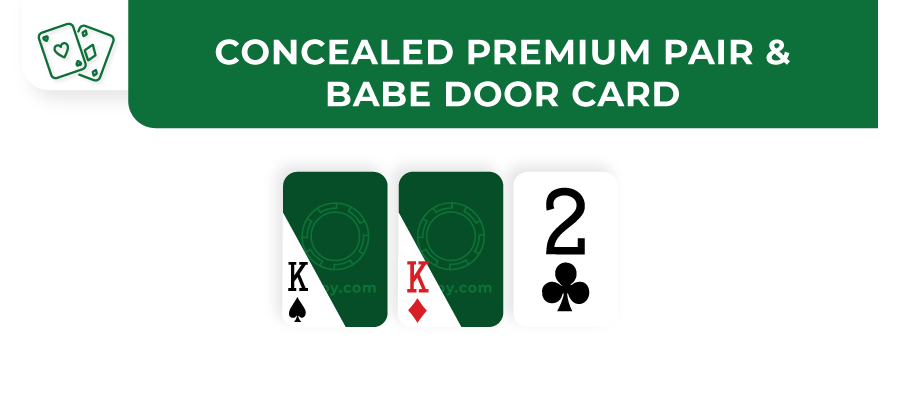
This is a potentially dangerous hand, that has very little shot at low, but may convince low draws to fold if it develops in that direction.
You have to be concerned about anyone catching an Ace, since it’s likely that a low hand started with an Ace in the hole in this game.
Uncoordinated Razz hands, without an Ace, headed by the 7 or higher:

These have little chance of making good high hands.
They are playable if the cards that are needed are very live and if they are against a couple or more high hands and no apparently better low hands.
You cannot have a made low on fourth street. You still need to catch a fifth low card. You still want two-way opportunities.
If the pot is heads up, and you have no chance at high, and your low hand hasn’t improved to four to a low, now is the time to dump your hand to a bet.
On the other hand, if your hand is developing toward a possible two-way winner, you can bet here, even though you haven’t made your low.
You do not have to wait until fifth street, and a made low hand, to bet.
For example
If you have (Ah 3h) 4h 5s, and your opponent with (x x) 7s 8h checks, you should go ahead and bet though you don’t have a made hand. Your low draw is far ahead of his low draw; you have an Ace, giving you three outs for a pair of Aces; you have a backdoor flush draw; and you have a gut shot draw to a straight.
You are clearly leading, so don’t wait to hit in one direction. Bet!
In general, don’t slowplay. Bet your hand. Don’t worry about knocking out all opponents. Scooping a modest pot is generally more profitable than splitting a large one.
If you are drawing for low, and don’t hit a fourth low card, and your opponent appears to be going high and bets, don’t draw a fifth card in the hope of winning half the pot unless the pot is already very large.
If, for example you have a hand like (5c 2c) 6s Ks, and your opponent has (x x) Qs Tc, and bets, you should generally fold unless there was a lot of betting and raising on third street.
True, you might catch two good low cards out of the next three and make your low. You might even hit two perfect cards and scoop. But if the hand is heads up, it’s not worth the cost. Fold now.
On the other hand, if the pot is already fairly large and continues to be multi-way, with two or more opponents who are seemingly going for high, and you can get in for a single small bet, you can chance drawing.
For example
With the following hand, if there was a bet and raise on third street with three of you seeing fourth, and you get a brick, but have three babes, and your good cards are live, you can call a single bet.
- YOU: (As 3s) 5c Kc;
- Bob: (x x) Kd 9c;
- Biff: (x x) Qs Ts.
If Bob bets and Biff calls, you can call.
Bets double on this street. It’s the time to toss your low draws if they don’t improve to at least four to the leading low. However, if it looks like you’re drawing to a second-best low, you should dump your hand.
On the other hand, you want to bet and raise to squeeze out potential draws against you when you have a scary board with freerolling potential. Here are two examples.
In this example you have a good high and a scary low board. Put pressure on your opponent by betting and raising if possible.
- YOU: (As 6c) 2d 5h Ad;
- Biff: (x x) 5c 7d 6c;
- Bob: (x x) Kc Jc Js.
Bob is high with his pair of Jacks and bets. Don’t call, hoping to catch a low card on sixth street. You should raise here to drive out Biff, who may well have a made low.
That way, you have a good shot at the whole pot, with your pair of Aces and low draw.
Your raise may also get Bob to fold (wishing he had never bet to begin with), fearing you are freerolling with a made low, or ahead with Aces, Aces up, or a straight.
If your opponent is poor enough to bet this hand (presumably with Kings up), you should raise here, representing the made low and the possible wheel.
True, you may well be behind with just a pair of Aces, but you have great draws and a very scary board.
Sixth street Stud 8 strategy, in a multiway hand, differs markedly from that of Stud or Razz in that you need to be aware of the possibility of facing four bets, not just one. The play is not automatic, and sometimes a bit complicated for this reason.
In Stud or Razz, it makes sense to call on sixth street with a reasonable draw to a winning hand since the pot is typically so large compared to the cost of a single bet. Not so with Stud 8.
In Stud 8, with two opponents, each betting aggressively, you could face four big bets on this street.
Accordingly, you have to be much more selective in the hands you play. You only want to play this street against two raising opponents when you are reasonably assured of winning one half of the pot; and ideally, when you are freerolling for the whole pot.
For example, you don’t want to play in the following situation:
- YOU: (2c 3c) 5d 7d Kc 8c;
- Joe: (x x) Ac 7c 9s 4c
- Zak: (x x) Kd Js Jd Qs
Joe bets. Zak raises. Get OUT!
Joe’s bet indicates either a flush higher than your flush draw, a low or low draw likely better than your low, or BOTH!
It also indicates that Joe will likely raise again if you call. Zak’s raise indicates that he too may be ahead of the high hand you are drawing for and may cap the raise if Joe raises again.
You may well be drawing dead. And you are likely to be whipsawed to death if you call. You should get out now.
On the other hand, if your hand were slightly different you could surely call. Consider the following.
- YOU: (Ac 4c) 5d 2d Kc 8c;
- Joe: (x x) Ad 7c 9s 8d;
- Zak: (x x) Kd Js Jd Qs.
In this instance you already have a leading low and an excellent low draw, with a draw for a very strong hand for high. While you’re not sure to win both ends of the pot, you are strongly in the lead for low and have a fair chance at scooping with the right draw.
Strategic Considerations on the River
Once again, Stud 8, unlike Stud and Razz, may require you to call four big bets, instead of just one on the river, with you only winning half of the pot.
Accordingly, a call is not nearly as automatic as it is in those other games. If you think you may well be second best, with little chance of scooping, and your call won’t end the betting, you have to seriously think about folding.
Here's an example of that:
- BOB: (x x) 7h 2d Kc As (x);
- ZAK: (x x) Ts 9c 9s Th (x);
- YOU: (3c 7d) 4s 6s Jd 8s (Qs).
Bob bets. Zak raises. What do you do?
Yes, you have a shot at winning low. If it were razz against just Bob, you’d probably have to call because of the pot odds you’d be getting. But Stud 8 is different. You have a rough 8 for low but no high hand. You’re likely going to face four bets, not one, to find out if your low is any good. And even if you win low, you’re only winning half the pot. Fold to the double bet.
In Stud and Razz, you typically bet to either knock out opponents or get money into a pot that you expect to win. In Stud 8, because of the split pots, your correct betting action is sometimes more complex.
Here’s an example of that:
It’s sixth street. You are a lock for low and have little or no shot at high. Your opponent bets and you are next to act. How do you proceed here?
- Bob: (x x) Qc 9c 8s Ac Bet;
- YOU: (Ac 2s) 4d 5s Kd 7c ???;
- Biff: (x x) Qd Jh Js Tc.
On the one hand, with a lock for low, you might think you should raise. But that would be a mistake in this instance.
You are almost surely splitting the pot with the high, no matter what your river card. You should call, to encourage Biff to call. To maximize your profit you want two people fighting over high. If you raise, and the double bet knocks out Biff, you will probably just split with Bob, making you less money.
Think about where your money will come from, and bet or raise accordingly.
Conclusion
There you have it - the complete guide on how to play Stud 8.
Now you understand why Stud 8 is usually considered the most profitable game for the experienced poker player.
That’s because you are likely to be playing against many players who don’t understand the importance of playing to scoop the pot.
By applying the strategic concepts explained above, you will gain a large advantage over those players.
With some experience, you should also be able to win consistently at this game, but you can always learn about all the poker variants and strategies from my Academy guides..

Bonuses
Casinos
Games
Academy
News
Shop
NEW Q&A
Sweepstakes






































